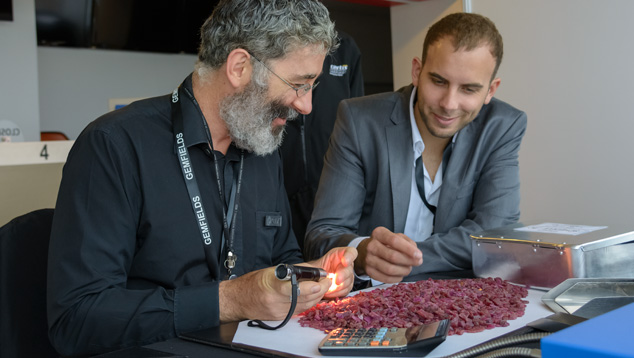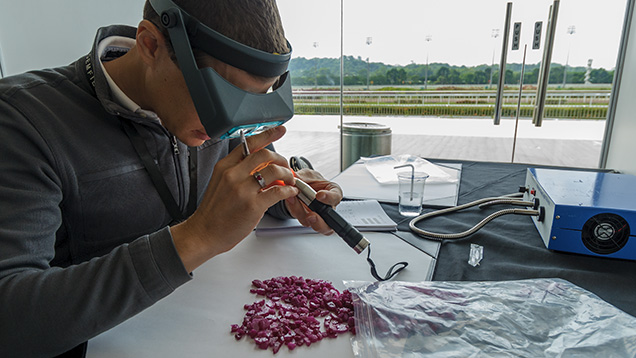Gemfields Inaugural Rough Ruby Auction in Singapore
July 17, 2014


Now, for the first time, the legal owners of the mining license in Montepuez have introduced their product into the marketplace at auction. This development has stirred up excitement (leavened with some fear) in both Thailand and India, signaling as it does a seismic shift in the way rubies will enter the market. This groundbreaking event took place between June 12 and June 17, 2014. It was held in Singapore, considered one of the world's easiest countries for doing business. The source of the rough was Montepuez Ruby Mining Limitada. Gemfields had proposed acquiring a 75 percent interest in this deposit on June 8, 2011, and completion of the acquisition was announced on February 27, 2012. A 25-year mining license was issued at that time. Bulk sampling began in November 2012. By March 3, 2014, the mine had produced 8.2 million carats of ruby and other corundum. As of the auction date, Gemfields’s total expenditures at the Montepuez mine had reached US$34 million, including costs of acquiring the mining rights.

Gemfields
Gemfields (GEM) is a publicly traded company listed on the AIM market of the London Stock Exchange, where it is a constituent of the AIM50 index. In July 2008, the company acquired a 75 percent interest in the Kagem mine in Zambia, one of the world’s principal emerald-producing mines. In July 2009, Gemfields held its first rough emerald auction. Since then, the company has held 15 auctions of rough emeralds from its Kagem mine as well as two auctions of emeralds from other sources. Its total revenue for all emerald auctions to date is US$282 million. All together, sales for the financial year ending June 30, 2014, including emerald rough as well as ruby rough from the June auction, exceeded US$143 million.Gemfields also owns other mining interests, including 50 percent of the Kariba amethyst mine in Zambia and licenses in Madagascar for ruby, sapphire, and emerald deposits. Gemfields acquired the Fabergé luxury jewelry brand in January 2013, giving the company a position in the luxury colored gemstone market.
Covering the Auction
At the auction, the GIA team examined and evaluated several ruby lots offered for sale. We also interviewed Gemfields staff directly involved in the grading and creation of the lots and in setting up and operating the auction, as well as more than two dozen auction attendees.


Comparing Singapore and Myanmar Auctions
A few of the buyers interviewed also regularly attend rough ruby auctions in Myanmar. It was interesting to hear them compare the two auction systems and how the differences affected their buying. They all said the Gemfields auction featured more sophisticated grading criteria, and the lots were better organized by size and quality. Far more lots were offered there than at the Myanmar auctions, and they were broken down into narrower categories of detailed size and quality ranges.Unlike Singapore, the Myanmar auction allows bids to be placed on one lot at a time. The results are declared before bids have to be submitted for the next lot. This allows buyers to know if they were successful on the first lot before bidding on the next lot, and so on. At the Gemfields auction, buyers had to submit bids for any lots they were interested in ahead of time. This meant buyers had to place bids on lots knowing that they might exceed their available capital if they were successful on most of their bids.

Auction Logistics
The Gemfields auction offered 32 tables with similar natural lighting conditions and a total of 62 rough ruby lots. Buyers had a schedule book listing the bid schedules available at each table. When a table was free, interested buyers would sit and go through the lots in the bid schedule at that table. Each auction book page listed bid schedule, table number, disclosure of any treatment, numbered lots included in that bid schedule, Gemfields grade, gram weight or millimeter size range, number of pieces and total weight for that lot, and total number of pieces and total weight for the entire bid schedule. There were also sections in the book for buyers to list their own graded price per gram and total price in US$ for each lot in the bid schedule, as well as the price they would bid for the entire schedule. At the bottom of each page was a space for the company name, bidder’s name, bid amount in US$, and the amount again to be written in words. Buyers submitted bids by filling out and signing the page.

Outcome
Overall, the auction was a resounding success. Fifty-five companies placed bids, a record number for any Gemfields auction. Fifty-seven of the 62 offered lots were sold, a total of 91 percent by value and 90 percent by weight. Out of the 2.03 million carats of rough ruby offered, 1.83 million carats were sold. The total revenue generated was US$33.5 million. The total expenditure by Gemfields into the Montepuez mine was US$34 million by the time of the auction.Auction buyers were satisfied. The Gemfields crew seems to have set reasonable reserve prices on the lots, and failure to reach the reserve price was not an issue. Gemfields seemed very open to feedback from the buyers on the auction process and the grading of lots for sale. Gemfields expects to narrow the invited companies down from 55 to somewhere in the 30s. They will use auction results to determine which companies to invite back on an ongoing basis. The next ruby auction is expected to take place before the end of 2014.

attendees for viewing and evaluating lots and placing bids.
| Table 1. Auction Results Summary | ||
| Auction Results (Ruby and Corundum) | June '14 Auction | |
| Dates | 12-17 June 2014 | |
| Location | Singapore | |
| Type | Rough ruby and corundum | |
| Carats offered) | 2.03 million | |
| Carats sold | 1.82 million | |
| No. of companies placing bids | 55 | |
| No. of lots offered | 62 | |
| No. of lots sold | 57 | |
| Percentage of lots sold | 92% | |
| Percentage of lots sold by weight | 90% | |
| Percentage of lts sold by market value | 91% | |
| Total sales realized at auction | US$33.5 million | |
| Average per carat sales value | US$18.43/carat | |
Conclusion
The colored stone industry has been moving toward companies with greater investments in mining and more vertical integration through the value chain. Although most global colored stone production still comes from artisanal and small-scale mining, larger companies with deep pockets are now strategically positioning themselves. Gemfields’s first Mozambique ruby auction follows their successful emerald auctions in establishing an organized and transparent process for rough colored gemstones to reach the market.
Vincent Pardieu is senior manager of field gemology at GIA in Bangkok; Andrew Lucas is manager of field gemology at GIA in Carlsbad, California.
The authors would like to thank the entire Gemfields staff, including Ian Harebottle, CEO; Dev Shetty, COO; Gabriella Harvey, director of cut and polished sales; Yogesh Khatoria, director of Gemfields India; Sanjay Kumar, project manager of Montepuez Ruby Mining; Frankie Fong, Gemfields’s Thailand representative; Adrian Banks, product director; Etienne Marvillet, product manager at the Kagem emerald mine (Zambia); Pia Tonna, business relationship director; and Philippe Ressigeac, assistant product manager at the Montepuez ruby mine (Mozambique). The authors would also like to thank the auction attendees for sharing their insights regarding the auction and the ruby industry in general.



